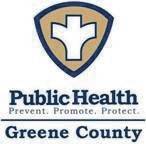
XENIA — The Ohio Department of Health is seeing an increased number of mumps cases.
Eighteen cases of mumps have been reported in 2017, compared to six reported mumps cases for the same time period in 2016. Fifteen of the current cases are associated with two outbreaks in Ohio. A community outbreak in Mercer County has 12 reported cases, and the University of Dayton in Montgomery County has an outbreak of three reported cases.
There are no current cases of mumps known to be related to the outbreaks above, but there have been eight suspect cases and one confirmed case in Greene County over the past five years.
There are several large mumps outbreaks currently occurring throughout the U.S., and health officials at Greene County Public Health (GCPH) remain steadfast in reminding residents that vaccinations are the most effective way to prevent illness from vaccine-preventable diseases, including mumps.
Mumps is spread by droplets of saliva or mucus from the mouth, nose or throat of an infected person, usually when the person coughs, sneezes or talks. Items used by an infected person, such as cups or soft drink cans, can also be contaminated with the virus, which may spread to others if those items are shared. Mumps is best known for the puffy cheeks and swollen jaw that it causes. This is a result of swollen salivary glands.
The most common symptoms include: fever, headache, muscle aches, tiredness, loss of appetite, and swollen and tender salivary glands under the ears on one or both sides.
People with mumps are usually contagious from two days before to five days after they develop symptoms. A person is most contagious just before symptoms appear. Symptoms typically appear 16-18 days after infection, but this period can range from 12-25 days after infection. Some people who get mumps have very mild or no symptoms, and often they do not know they have the disease. Most people with mumps recover completely in a few weeks.
What to do if you or someone you know becomes infected with the mumps:
-Stay home from work or school for five days after your glands begin to swell, and try not to have close contact with other people who live in your house.
-Minimize close contact with other people, especially babies and people with weakened immune systems who cannot be vaccinated.
-Cover your mouth and nose with a tissue when you cough or sneeze, and put your used tissue in the trash can. If you don’t have a tissue, cough or sneeze into your upper sleeve or elbow, not your hands.
-Wash hands well and often with soap, and teach children to wash their hands too.
-Don’t share drinks or eating utensils.
-Regularly clean surfaces that are frequently touched (such as toys, doorknobs, tables, counters) with soap and water or with cleaning wipes.
GCPH supports the vaccine recommendations set forth by the Advisory Committee on Immunization Practices (ACIP) and the Centers for Disease Control and Prevention (CDC). These recommendations include schedules for when children and adults should receive their vaccinations. Mumps can be prevented with MMR vaccine. This protects against three diseases: measles, mumps, and rubella. CDC, along with Greene County Public Health, recommends children get two doses of MMR vaccine, starting with the first dose at 12 through 15 months of age, and the second dose at 4 through 6 years of age. Teens and adults should also be up to date on their MMR vaccination. MMR vaccine is very safe and effective. The mumps component of the MMR vaccine is about 88 percent (range: 66-95 percent) effective when a person gets two doses. One dose is about 78 percent (range: 49−92 percent) effective.
To access the current CDC recommended immunization schedules, visit: http://bit.ly/2mmyNed. More information is available from the CDC at http://bit.ly/2mmpLxU.
“Immunization is the most effective way to protect yourself and your family from vaccine-preventable diseases,” said Health Commissioner Melissa Branum. “In addition, to reduce the spread of infectious diseases, such as mumps, wash your hands often, cover your cough, and stay home when you are ill.”
Greene County residents are encouraged to consult with their health care provider if they have questions regarding their immunization status, or call the health district at 937-374-5600.




